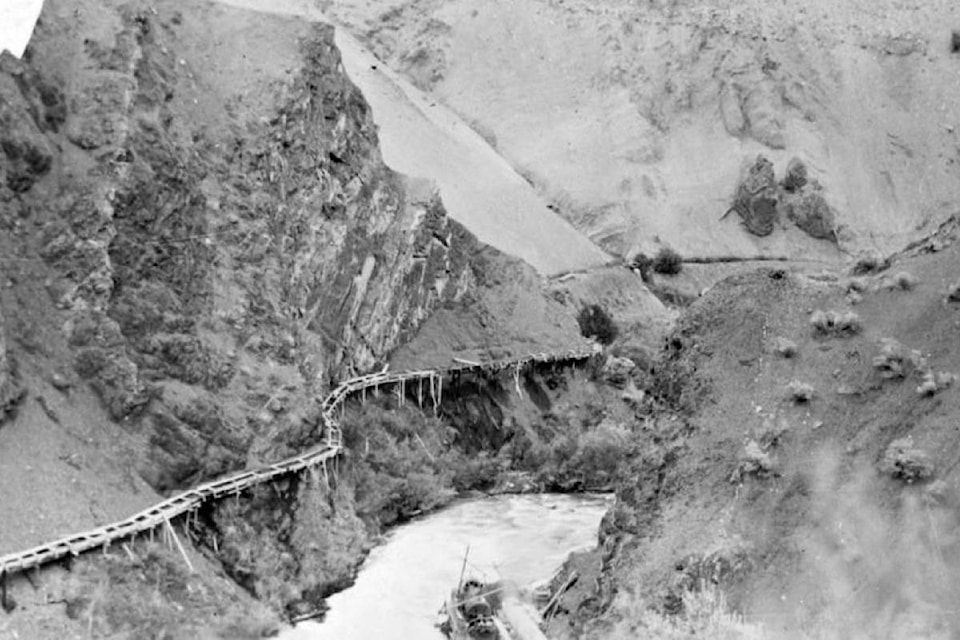When the Ashcroft Water, Light and Power company was formed late in 1897, bringing water and power to the town was very much at the forefront of the consortium’s plans. However, the men behind the venture were nothing if not ambitious, and they had some grand plans.
In October 1898, as Ashcroft experienced the wonders of electricity for the first time, the company announced that they would build a sawmill at the site of their dam on the Bonaparte River. “Logs will be rafted down the Bonaparte at high water a distance of 30 or 40 miles, where fine timber limits are secured of fir and yellow pine of a good quality,” reported the Journal. “Planers, edgers, etc. will be installed to properly dress and prepare all timbers and lumber for building and fencing in this section for when there is a large and growing demand.
“The company have already called for tenders for furnishing 2,000,000 feet of sawlogs to be delivered next spring at the dam.”
In November 1898 there was still optimism about the sawmill project, which was now projected to have a capacity of 3,000,000 feet annually, and be located on the Thompson River above town (presumably someone had taken a second look at the Bonaparte and realized the difficulty of sending logs down it). J.C. Barnes had given the company 1,000 feet of frontage on the river bank, in an area felt to be sufficiently deep to provide a good yard.
“The idea of the company is to be enabled to run logs down both the Bonaparte and North Thompson, and start a large lumber plant to work… There will be a fair home market for lumber, and the present high prices leads them to believe that it can be shipped and sold along the line of railroad at a fair profit.
“The logs can be be well held in the slough near the Evans ranch, and Kamloops Lake will readily act as a safe place to reservoir the rafts sent down the North Thompson from the Clearwater country. The mill is bought and ready for shipment, but whether the company finally conclude to erect it on the Thompson or the Bonaparte is the open question.”
The answer to that question ended up being “Neither.” The proposed sawmill was never built, and neither were the brick kilns that company founder John Shields wanted to build near Ashcroft, for the making of bricks from local clay. There was talk of a railway to the Cariboo, with Ashcroft and Kamloops each vying to be the starting point, and Ashcroft Water, Light, and Power lobbied in favour of Ashcroft, with their company to supply the power. In the end, however, nothing came of this scheme either.
The one plan that did come to fruition was supplying water to Boston Flats and the adjoining valley, northwest of Ashcroft. The area had first been cultivated by William Henry Sanford, known far and wide as “Boston” Sanford, in 1871, with water supplied from Cache Creek via a ditch that began six miles above Cache Creek and ran for 10 miles in total. The fertility of the land there was well known, if only water could be got to it, and the potatoes Sanford grew had a very good reputation. An early commentator noted that “the celebrated Boston ranch is one of the finest farms in the colony.”
A wooden flume was constructed along the Bonaparte to take water to Boston Flats, the land there having been leased by the company. “There is between 2,000 and 3,000 acres of splendid land that can be utilized,” said the Journal in October 1898. “Within a few years the well known Boston Flats will be second to no farm or ranch in British Columbia.”
While that grand claim never came true, the area at Boston Flats was cultivated for many years with water pumped through the flume from the pumphouse on the Bonaparte (parts of the wooden flume still remain, and a section can be seen from the former trailer park site). During the years when the Ashcroft cannery was in operation tomatoes were grown there, but when the cannery closed in 1957, agriculture at Boston Flats gradually ceased.
A power plant remained on the Bonaparte until about the same time, although it had been rebuilt following fire and floods in 1938, 1948, and 1950. By then it had been purchased by the B.C. Electric Railway Co., which later became BC Hydro. Shortly after purchasing the plant, BCE extended a 60,000 volt line to Ashcroft from Lillooet, and the power plant was dismantled, although traces of it still remain on the Bonaparte, out of the sight of modern eyes below Highway 97C.
editorial@accjournal.ca
Like us on Facebook and follow us on Twitter
